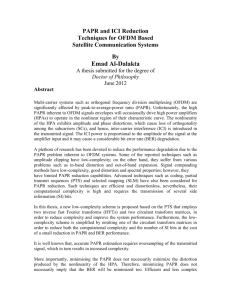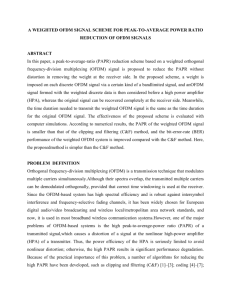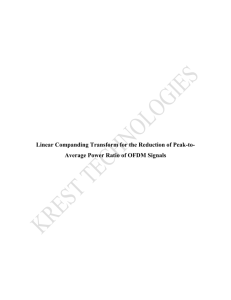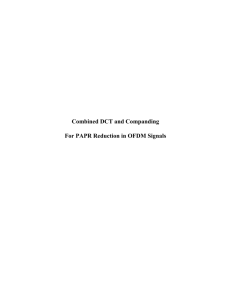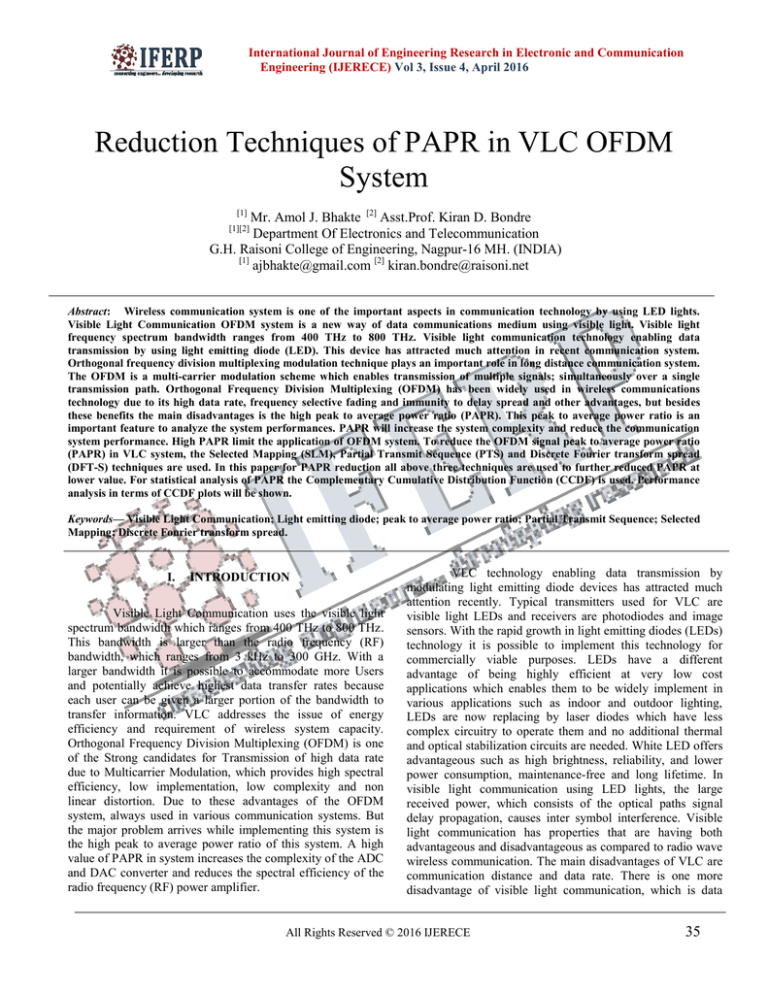
International Journal of Engineering Research in Electronic and Communication
Engineering (IJERECE) Vol 3, Issue 4, April 2016
Reduction Techniques of PAPR in VLC OFDM
System
[1]
Mr. Amol J. Bhakte [2] Asst.Prof. Kiran D. Bondre
[1][2]
Department Of Electronics and Telecommunication
G.H. Raisoni College of Engineering, Nagpur-16 MH. (INDIA)
[1]
ajbhakte@gmail.com [2] kiran.bondre@raisoni.net
Abstract: Wireless communication system is one of the important aspects in communication technology by using LED lights.
Visible Light Communication OFDM system is a new way of data communications medium using visible light. Visible light
frequency spectrum bandwidth ranges from 400 THz to 800 THz. Visible light communication technology enabling data
transmission by using light emitting diode (LED). This device has attracted much attention in recent communication system.
Orthogonal frequency division multiplexing modulation technique plays an important role in long distance communication system.
The OFDM is a multi-carrier modulation scheme which enables transmission of multiple signals; simultaneously over a single
transmission path. Orthogonal Frequency Division Multiplexing (OFDM) has been widely used in wireless communications
technology due to its high data rate, frequency selective fading and immunity to delay spread and other advantages, but besides
these benefits the main disadvantages is the high peak to average power ratio (PAPR). This peak to average power ratio is an
important feature to analyze the system performances. PAPR will increase the system complexity and reduce the communication
system performance. High PAPR limit the application of OFDM system. To reduce the OFDM signal peak to average power ratio
(PAPR) in VLC system, the Selected Mapping (SLM), Partial Transmit Sequence (PTS) and Discrete Fourier transform spread
(DFT-S) techniques are used. In this paper for PAPR reduction all above three techniques are used to further reduced PAPR at
lower value. For statistical analysis of PAPR the Complementary Cumulative Distribution Function (CCDF) is used. Performance
analysis in terms of CCDF plots will be shown.
Keywords— Visible Light Communication; Light emitting diode; peak to average power ratio; Partial Transmit Sequence; Selected
Mapping; Discrete Fourier transform spread.
I.
INTRODUCTION
Visible Light Communication uses the visible light
spectrum bandwidth which ranges from 400 THz to 800 THz.
This bandwidth is larger than the radio frequency (RF)
bandwidth, which ranges from 3 kHz to 300 GHz. With a
larger bandwidth it is possible to accommodate more Users
and potentially achieve highest data transfer rates because
each user can be given a larger portion of the bandwidth to
transfer information. VLC addresses the issue of energy
efficiency and requirement of wireless system capacity.
Orthogonal Frequency Division Multiplexing (OFDM) is one
of the Strong candidates for Transmission of high data rate
due to Multicarrier Modulation, which provides high spectral
efficiency, low implementation, low complexity and non
linear distortion. Due to these advantages of the OFDM
system, always used in various communication systems. But
the major problem arrives while implementing this system is
the high peak to average power ratio of this system. A high
value of PAPR in system increases the complexity of the ADC
and DAC converter and reduces the spectral efficiency of the
radio frequency (RF) power amplifier.
VLC technology enabling data transmission by
modulating light emitting diode devices has attracted much
attention recently. Typical transmitters used for VLC are
visible light LEDs and receivers are photodiodes and image
sensors. With the rapid growth in light emitting diodes (LEDs)
technology it is possible to implement this technology for
commercially viable purposes. LEDs have a different
advantage of being highly efficient at very low cost
applications which enables them to be widely implement in
various applications such as indoor and outdoor lighting,
LEDs are now replacing by laser diodes which have less
complex circuitry to operate them and no additional thermal
and optical stabilization circuits are needed. White LED offers
advantageous such as high brightness, reliability, and lower
power consumption, maintenance-free and long lifetime. In
visible light communication using LED lights, the large
received power, which consists of the optical paths signal
delay propagation, causes inter symbol interference. Visible
light communication has properties that are having both
advantageous and disadvantageous as compared to radio wave
wireless communication. The main disadvantages of VLC are
communication distance and data rate. There is one more
disadvantage of visible light communication, which is data
All Rights Reserved © 2016 IJERECE
35
International Journal of Engineering Research in Electronic and Communication
Engineering (IJERECE) Vol 3, Issue 4, April 2016
rate. Its data rate is between kilobits per second to 10 megabits
per second. The data communication range of visible light
communication is typically between 1 to 90 meters. This
distance is too short as compared to radio-wave
communication, due to the fact that visible light
communication is line-of-sight communication, which means
that data communication is interrupted when there is an object
present between a transmitter and a receiver.
The PTS method is a typical algorithm of signal
scrambling techniques. It was first introduced by S. H. Muller
and J. B. Huber in 1997.The PTS method is adopted to carry
out random phase weighting to the signal to reduce the OFDM
signal peak value probability signal appears, thereby reducing
the PAPR of OFDM signal. The PTS is effective distortion
less PAPR reduction techniques. It provides PAPR reduction
and good BER performance in VLC as compared with
clipping and filtering.
II. OFDM AND PAPR OVERVIEW
The OFDM is a multi-carrier modulation scheme
which enables
transmission of
multiple
signals;
simultaneously over a single transmission path. OFDM uses in
wireless communications system because of its high data rate
handling capacity. One of the main disadvantages of OFDM is
the high PAPR. PAPR is an important criterion to measure the
communication system performances. Presence of PAPR in
VLC system will increase the system complexity and reduced
performance. In VLC systems, intensity modulation is used at
the transmitter. The forward signal drives the LEDs which in
turn converts the magnitude of the electric signal into optical
intensity. The human eye cannot see the fast-changing
variations of the light intensity, and only responding to the
average light intensity. A photodiode (PD) convert the
received incoming optical power into the amplitude of an
outgoing electrical signal. High PAPR value for the fixed
number of data bits per sample introduces the serious
quantization error. To minimize this quantization error, the
accuracy should be increased. As a result the complexity of
ADC and DAC will increase. To overcome this problem,
linear amplifiers are needed
PAPR is given by:
max | x(n) | 2
PAPR 0 n N
p average
The complementary cumulative distribution function of
the PAPR of OFDM signals is used to evaluate the PAPR
reduction performance accurately from the statistical analysis.
CCDF plot helps us to measure the probability that the PAPR
of a certain data block exceeds the given threshold value
which is given as:
CCDF (PAPR(x(n))) = Pr(PAPR(x(n)) > PAPR0
Figure 1.The block diagram of the PTS method in VLC
system
PTS method used in VLC OFDM system block
diagram is shown in figure1.In this PTS method the input data
symbols in X are partitioned in to M disjoint sub blocks. The
sub blocks X(i) are transformed in to M time-domain partial
transmit sequences. These sequences are independently rotated
by some phase factors (bi), These signals are then combined to
produce the time domain OFDM signal packet back. PTS
algorithm selects a vector (bi) such that the PAPR of the
corresponding transmit sequence x(t) will be the lowest.
However PTS is computationally complex and need to
transmit appropriate side information. In PTS, many
researchers are trying to reduce computational complexity in
different ways because selection of optimized phase vector is
tedious process. For reducing the OFDM signal PAPR value
in VLC system, the Partial Transmit Sequence method is
combined with Discrete Fourier transform spread are used.
B. Selected Mapping
III. PAPR REDUCTION TECHNIQUES
To reduce OFDM signal PAPR in VLC system,
Partial Transmit Sequence (PTS), Discrete Fourier transform
spread (DFTS), and selected mapping (SLM) techniques are
used.
A. Partial Transmit Sequence
SLM is the most popular PAPR reduction method in
VLC. By choosing efficient phase rotation factors the PAPR
performance of SLM-OFDM is improved. This will reduce the
information data rate and increase the size of side information.
All Rights Reserved © 2016 IJERECE
36
International Journal of Engineering Research in Electronic and Communication
Engineering (IJERECE) Vol 3, Issue 4, April 2016
Figure 2.The block diagram of the SLM method in VLC
system
SLM-OFDM system used with limited size of side
information, the number of selected phase rotation factors is
also being limited. Figure 2 shows the block diagram of SLM
technique in VLC OFDM system. In SLM method input data
symbols X are partitioned in to the blocks.The original input
data X[X0,X1,….X(N-1)]T multiplied with independent phase
sequences P(u) = [P(u)0,P(u)1,..P(u) (N-1)]T, u=(0,1,U-1),
where U is the number of phase sequences. After
multiplication, inverse discreet Fourier transform (IDFT) will
be applied on each sequence to convert the signal from
frequency domain to the time domain. The last step is
comparing the PAPR among the independent data blocks and
the candidate with the lowest PAPR will be selected for
transmission.
The PAPR performance was increase with more
rotated groups present in SLM, but more data bits of side
information are required also the data rate is lower.The OFDM
signal with the lowest PAPR is selected for light transmission
in the SLM method. Unlike the conventional PTS, SLM is not
required to transmit and recover the side information about the
phase rotation. SLM technique avoids the side information
requirement at the receiver by cyclic shifting the pilot
subcarriers for each of the independent mappings in pilot
assisted SLM-OFDM systems. The effectiveness of the
method is presented in presence of SSPA for marine channel.
Figure 3.The block diagram of the DFT method in VLC
system
With this DFTS technique, the theoretical analysis is
firstly carried out to help characterize the OFDM system
PAPR reduction value in VLC systems. In this method the
data input symbols are first encoded and converted from serial
to parallel before transforming the symbols to frequency
domain by DFT operation are shown in figure3. After that the
OFDMA modulation is then performed followed by pulse
shaping filter that shape the signal to get the desired spectrum
and then transmit the analogue signals through a channel after
DAC conversion. Since different subcarriers in the frequency
domain are occupied by every user like in OFDMA technique.
On the basis of this result detail comparisons of DFTSpread OFDM with other techniques in terms of OFDM
PAPR reduction are made for VLC systems. Simulation
results analysis shows that the DFTS system reduced PAPR in
OFDM system and also achieves a high performance gain in
BER without any losses in the system transmission rate.
IV. SIMULATION ANALYSIS
The following simulation CCDF plot through
MATLAB, PTS, SLM and DFTS verify the performance of
PAPR under visible light communication in OFDM system.
C. DFT-Spread
DFT-S OFDM has been proven one of the most
effective ways to reduce OFDM signal PAPR. On the basis of
subcarrier allocation patterns, DFT-S OFDM system can be
divided into interleaved DFT-Spread (IDFT-S) OFDM and
localized DFT-Spread (LDFT-S) OFDM. In Visible Light
Communication systems, the requirement of real signals,
special circular conjugate symmetry constraints are imposed
on to the OFDM subcarriers. It makes the DFT-Spread OFDM
implementation in VLC quite different from the conventional
DFT-Spread OFDM structure.
Figure4. Simulation of PAPR performance of the SLM, PTS
and DFT algorithm
The above figure 4 shows the CCDF plot for the
performance of different PAPR reduction techniques. The
PTS method used in VLC OFDM system reduced PAPR
All Rights Reserved © 2016 IJERECE
37
International Journal of Engineering Research in Electronic and Communication
Engineering (IJERECE) Vol 3, Issue 4, April 2016
approximately by 2.2 dB. SLM method used in VLC OFDM
system reduced PAPR approximately by 3.7 dB. DFT-S
method used in VLC OFDM system reduced PAPR
approximately by 1.33 dB.
To Average Power Ratio (Papr) Reduction In Ofdm
Based Radio Systems”, Master Of Science Thesis
Blekinge Institute Of Technology May 2010.
[9]
V. CONCLUSION
Chaopei Wu, Hua Zhang, and Wei Xu “On Visible Light
Communication Using LED Array with DFT-Spread
OFDM” Optical Networks and Systems. 978-1-47992003-7/14/$31.00 ©2014 IEEE.
In this paper, with the help of comparative study of
PAPR reduction techniques, Partial Transmit Sequence (PTS),
Selected Mapping (SLM) and Discrete Fourier transform [10] Prashant Kumar and Preetam Kumar “Performance
Evaluation of DFT-Spread OFDM and DCT-Spread
spread (DFTS) have been analyzed. It is observe that SLM
OFDM for Underwater Acoustic Communication” 978-1method for PAPR reduction has better PAPR reduction
4673-1881-5/12/$31.00 ©2012 IEEE.
performance than the other PTS and DFT methods.
REFERENCES
[1]
Yosuke Fujii^, Chang-Jun Ahn, Tatsuya Omori, and Kenya Hashimoto “PAPR Reduction for Visible Light
Communication OFDM using FSS and PPS” 978-1-47996435-2/14/$31.00 ©2014 IEEE.
[2]
M. M. Rana “Clipping Based PAPR Reduction Method
for LTE OFDMA Systems “International Journal of
Electrical & Computer Sciences IJECS-IJENS 10-9681005-1212 IJECS-IJENS © October 2010 IJENS.
[3]
Zeng Fulai, Liu Luokun, and Yang Jinjin “DFT-Spread
Combined with PTS Method to Reduce the PAPR in
VLC-OFDM System” Institute of Zhengzhou Information
Science and Technology 978-1-4799-3279-5 /14/$31.00
©2014 IEEE.
[4]
B.Somasekhar and A.Mallikarjunaprasad “Modified SLM
and PTS Approach to Reduce PAPR in MIMO OFDM”
Department of ECE, S.V.P.Engg.College, VSKP, A.P.,
India 978-1-4799-5748-4/14/$31.00 © 2014 IEEE.
[5]
Young-Ju Kim1, Xun Li2 “A Low PAPR Visible Light
Communication
System
Employing
SC-FDMA
Technique” . Appl. Math. Inf. Sci. 7, No. 2, 539-544
(2013)
[6]
Jyoti Mansukhani and Saswat Chakrabarti “Performance
Analysis of SLM for PAPR Reduction of OFDM Signal
in Marine Channel” 978-1-4673-2907-1/13/$31.00 ©2013
IEEE (ICCCI -2013), Jan. 04 – 06, 2013, Coimbatore,
INDIA
[7]
T Chalapathi, M. Madhu Babu. “A low computational
complexity algorithm for PTS based PAPR reduction
scheme in OFDM system,IJERT vol.1 3 May 2012.
[8]
Mohammad Zavid Parvez Md. Abdullah Al Baki “Peak
All Rights Reserved © 2016 IJERECE
38


